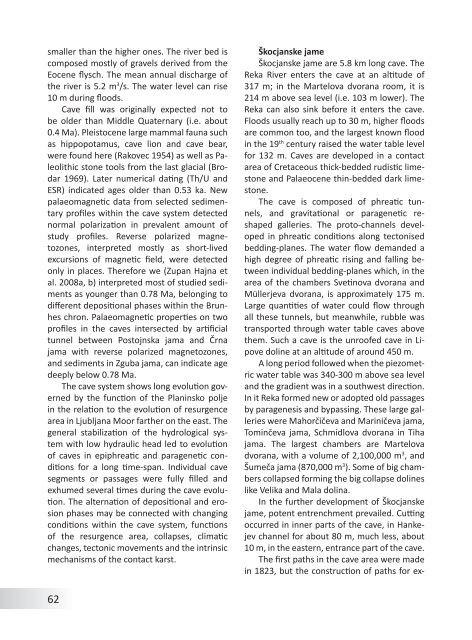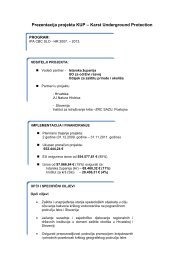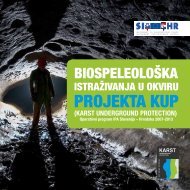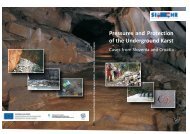Case Studies from the Dinaric Karst of Slovenia
Case Studies from the Dinaric Karst of Slovenia
Case Studies from the Dinaric Karst of Slovenia
You also want an ePaper? Increase the reach of your titles
YUMPU automatically turns print PDFs into web optimized ePapers that Google loves.
smaller than <strong>the</strong> higher ones. The river bed iscomposed mostly <strong>of</strong> gravels derived <strong>from</strong> <strong>the</strong>Eocene flysch. The mean annual discharge <strong>of</strong><strong>the</strong> river is 5.2 m 3 /s. The water level can rise10 m during floods.Cave fill was originally expected not tobe older than Middle Quaternary (i.e. about0.4 Ma). Pleistocene large mammal fauna suchas hippopotamus, cave lion and cave bear,were found here (Rakovec 1954) as well as Paleolithicstone tools <strong>from</strong> <strong>the</strong> last glacial (Brodar1969). Later numerical dating (Th/U andESR) indicated ages older than 0.53 ka. Newpalaeomagnetic data <strong>from</strong> selected sedimentarypr<strong>of</strong>iles within <strong>the</strong> cave system detectednormal polarization in prevalent amount <strong>of</strong>study pr<strong>of</strong>iles. Reverse polarized magnetozones,interpreted mostly as short-livedexcursions <strong>of</strong> magnetic field, were detectedonly in places. Therefore we (Zupan Hajna etal. 2008a, b) interpreted most <strong>of</strong> studied sedimentsas younger than 0.78 Ma, belonging todifferent depositional phases within <strong>the</strong> Brunheschron. Palaeomagnetic properties on twopr<strong>of</strong>iles in <strong>the</strong> caves intersected by artificialtunnel between Postojnska jama and Črnajama with reverse polarized magnetozones,and sediments in Zguba jama, can indicate agedeeply below 0.78 Ma.The cave system shows long evolution governedby <strong>the</strong> function <strong>of</strong> <strong>the</strong> Planinsko poljein <strong>the</strong> relation to <strong>the</strong> evolution <strong>of</strong> resurgencearea in Ljubljana Moor far<strong>the</strong>r on <strong>the</strong> east. Thegeneral stabilization <strong>of</strong> <strong>the</strong> hydrological systemwith low hydraulic head led to evolution<strong>of</strong> caves in epiphreatic and paragenetic conditionsfor a long time-span. Individual cavesegments or passages were fully filled andexhumed several times during <strong>the</strong> cave evolution.The alternation <strong>of</strong> depositional and erosionphases may be connected with changingconditions within <strong>the</strong> cave system, functions<strong>of</strong> <strong>the</strong> resurgence area, collapses, climaticchanges, tectonic movements and <strong>the</strong> intrinsicmechanisms <strong>of</strong> <strong>the</strong> contact karst.Škocjanske jameŠkocjanske jame are 5.8 km long cave. TheReka River enters <strong>the</strong> cave at an altitude <strong>of</strong>317 m; in <strong>the</strong> Martelova dvorana room, it is214 m above sea level (i.e. 103 m lower). TheReka can also sink before it enters <strong>the</strong> cave.Floods usually reach up to 30 m, higher floodsare common too, and <strong>the</strong> largest known floodin <strong>the</strong> 19 th century raised <strong>the</strong> water table levelfor 132 m. Caves are developed in a contactarea <strong>of</strong> Cretaceous thick-bedded rudistic limestoneand Palaeocene thin-bedded dark limestone.The cave is composed <strong>of</strong> phreatic tunnels,and gravitational or paragenetic reshapedgalleries. The proto-channels developedin phreatic conditions along tectonisedbedding-planes. The water flow demanded ahigh degree <strong>of</strong> phreatic rising and falling betweenindividual bedding-planes which, in <strong>the</strong>area <strong>of</strong> <strong>the</strong> chambers Svetinova dvorana andMüllerjeva dvorana, is approximately 175 m.Large quantities <strong>of</strong> water could flow throughall <strong>the</strong>se tunnels, but meanwhile, rubble wastransported through water table caves above<strong>the</strong>m. Such a cave is <strong>the</strong> unro<strong>of</strong>ed cave in Lipovedoline at an altitude <strong>of</strong> around 450 m.A long period followed when <strong>the</strong> piezometricwater table was 340-300 m above sea leveland <strong>the</strong> gradient was in a southwest direction.In it Reka formed new or adopted old passagesby paragenesis and bypassing. These large gallerieswere Mahorčičeva and Mariničeva jama,Tominčeva jama, Schmidlova dvorana in Tihajama. The largest chambers are Martelovadvorana, with a volume <strong>of</strong> 2,100,000 m 3 , andŠumeča jama (870,000 m 3 ). Some <strong>of</strong> big chamberscollapsed forming <strong>the</strong> big collapse dolineslike Velika and Mala dolina.In <strong>the</strong> fur<strong>the</strong>r development <strong>of</strong> Škocjanskejame, potent entrenchment prevailed. Cuttingoccurred in inner parts <strong>of</strong> <strong>the</strong> cave, in Hankejevchannel for about 80 m, much less, about10 m, in <strong>the</strong> eastern, entrance part <strong>of</strong> <strong>the</strong> cave.The first paths in <strong>the</strong> cave area were madein 1823, but <strong>the</strong> construction <strong>of</strong> paths for ex-62










